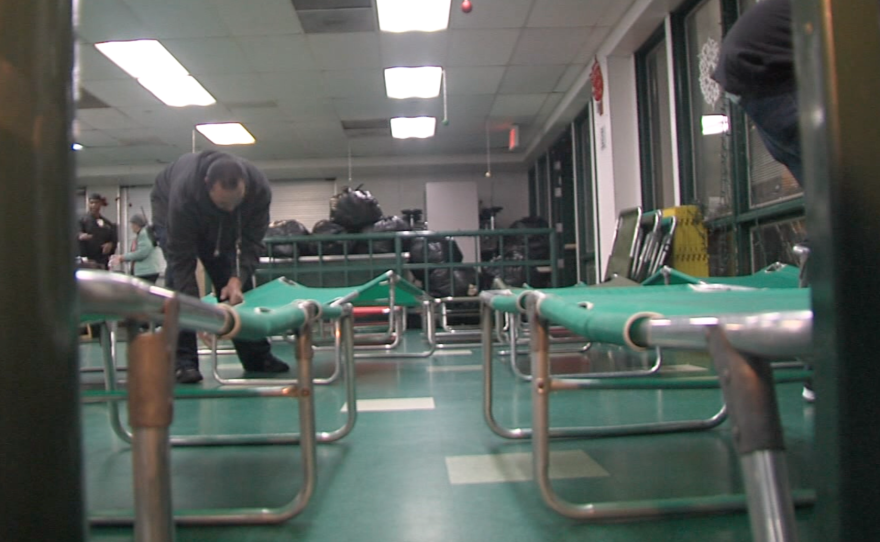This is San Diego's first winter without its homeless tents as the city embarks on a new strategy for getting people off the cold, wet streets.
Temperatures dipped low enough Monday to give the strategy a test run.
When forecasters predict temperatures below 50 degrees and a 40 percent or higher chance of rain, volunteers and staff with homeless services provider Father Joe's Villages get to work converting two cafeterias at St. Vincent De Paul Village and space at the Neil Good Day Center into sleeping quarters for 250 homeless individuals.
That's up from 100 emergency beds the agency previously offered.
Deacon Jim Vargas is president of Father Joe's Villages and said 66 people took shelter Monday night as wet weather moved down the coast.
"It's not unusual that it would have been that low. It was the first time this season, and so word has to get out," Vargas said. "There's a pretty efficient word-of-mouth system out there, so there's no doubt in my mind that as it gets progressively worse this winter that we'll be at capacity."
Vargas said his agency did some street outreach Monday afternoon to notify people they could get a meal and a mat to sleep on indoors between the hours of 4 p.m. and 5 a.m.
Though the new system increases the number of emergency beds at St. Vincent De Paul, many believe fewer beds are available overall this winter without the tents. Until this year, one in Barrio Logan housed 250 people and another in the Midway District housed 100 from November to March.
Vargas said Father Joe's has replaced the beds one-for-one and then some at its Paul Mirable Center in the East Village. There, 350 spaces are open year-round and are designed to get people into more stable housing.
In November, Councilman Todd Gloria told KPBS the facility was on pace to serve 2,700 individuals from April through December, with 52 percent moving on to long-term housing. That's more than double the number of homeless served over five months by the tents, which had a 26 percent success rate for putting people in long-term housing.
But the Paul Mirable beds are not brand new. People were sleeping in them when the city called for proposals to replace the tents.
At the same time, Father Joe's was about to lose its federal funding for the beds. The U.S. Department of Housing and Urban Development has been eliminating transitional housing programs because putting people straight into permanent housing with support services does a better job keeping people off the streets in the long run.
The Paul Mirable Center didn't meet the new funding criteria because it was running on an old model.
Now with city funding, the facility is considered interim housing, which is supportive emergency shelter for people who fall on hard times but are likely to get back on their feet within months, instead of years like those in transitional shelters.
Winter Homeless Services In San Diego
| Paul Mirable Center Through April 2015 | Paul Mirable Center After April 2015 | Homeless Tents Through 2014 | Emergency Beds for 2015 | |
| Location | East Village | East Village | Barrio Logan and Midway | East Village |
| Months in Operation | Year-Round | Year-Round | November to March | Inclement Weather |
| Shelter Type | Transitional | Interim | Emergency | Emergency |
| Beds | 350 | 350 | 350 | 250 |
| Funding | HUD | City | City | None Dedicated |
Since the change at the Paul Mirable Center, the number of residents transitioning into more stable housing has improved by about 10 percentage points. It's still lower than HUD's threshold of 65 percent for transitional programs.
And Vargas said it's a more humane solution than the tents.
"I think this is absolutely a better solution. Hands down. Beyond a shadow of a doubt," Vargas said. "Before, what we had were 350 temporary spaces out there under tents, which is no way for us to be treating our fellow human beings."
The Paul Mirable Center is currently at capacity with beds turning over every 45 to 60 days.
Critics of the change say it isn't a replacement for the tents, because it doesn't add overnight beds for the thousands of homeless in the county sleeping outdoors during the winter.
Other west coast cities – and the San Ysidro School District – have made moves in recent months that clear the way to use public buildings as overnight shelters during harsh storms.






